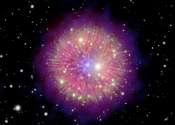German scientists investigate supernova remnant SNR G309.8+00.0 at high energies
Using Spektr-RG and Fermi space observatories, German astronomers have investigated the supernova remnant SNR G309.8+00.0 in X-rays and gamma rays. Results of the new study, presented June 25 on the preprint server arXiv, ...









